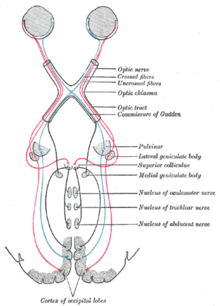Unique hues
Unique hue is a term used in certain theories of color vision, which implies that human perception distinguishes between "unique" (psychologically primary) and composite (mixed) hues.[1] A unique hue is defined as a color which an observer perceives as a pure, without any admixture of the other colors.[2] Ewald Hering first defined the unique hues as red, green, yellow, and blue, and based them on the concept that these colors could not be simultaneously perceived. For example, a color cannot appear both red and green; the color would cancel out to yellow.[3]
There is a great deal of variability when defining unique hues experimentally,[4] however, a single observer can usually set their experience of a unique hue extremely consistently, to within a few nanometers.[5] Unique hues can differ between people, and depend on the state of adaptation of the visual system. They are often used in psychophysical research to measure variations in color perception due to color abnormalities or color adaptation.[6]
The concept of certain hues as 'unique' came with the advent of Opponent process theory. Ewald Hering first proposed the idea that red, green, blue, and yellow were unique in 1892. His theory suggests that color vision is based on two opposing axes of color: a red-green axis and a blue-yellow axis. This theory is based strongly on the existence of perceptually impossible colors or color hue mixtures that have no meaning such as redgreen or yellowblue. These colors are perceptually impossible and suggest an opponent relationship between red and green, and blue and yellow.
While this theory was initially considered contradictory to Young and Helmholtz’s trichromatic theory,[7] the discovery of colour-opponent cells in the retina and LGN reconciled the two theories. It became widely accepted that the three cone types were recombined into three cone contrast pathways, two encoding colour, and one encoding luminance, thereby reducing the redundancy of correlated cone signals. The axes proposed for these recombinations are commonly taken to be L+M, S-(L+M), and L-M. [8]
The recombination of color signals into L+M, L-M, and S-(L+M) channels makes clear predictions for the physiological correlate of unique hues. The L-M axis, corresponding to the red-green axis proposed by Hering, should produce unique hues when maximally stimulated at either pole. Similarly, the yellow-blue (S-(L+M)) axis should produce unique hues when it is maximally stimulated at either pole. Hering suggested that these mutually exclusive hues would correspond to the ‘building up’ (assimilation) or ‘breaking down’ (dissimilation) of a visual substance corresponding to the red-green or blue-yellow colour axis.
Later research suggested that unique hues could be defined as the ‘equilibrium state’ of the red-green or blue-yellow cardinal axes.[9] This introduced the concept of ‘neutralisation’, where an equal stimulation of red and green light would cancel out to a neutral point on the red-green axis (which could correspond to yellow, white, or blue).

